
Article 25A of the Constitution on the Right to Education bears repeating ad infinitum: “The State shall provide free and compulsory education to all children of the age of five to 16 years in such manner as may be determined by law.” In 2009-10, the year when the Constitution (18th Amendment) Act was notified, expenditure on education was 1.77 per cent of GDP.
In the past 18 years, the percentage increased to just 2.2. The report recommends its increase to four per cent of GDP. Every education policy and report in the past set a similar wishful goal. Under the expected IMF Extended Fund Facility for the next three years, the maintenance of the present percentage itself would be a miracle.
However, this is the total education expenditure. What is relevant for putting out-of-school children in school and retaining those already in school is the proportion of expenditure on primary and secondary education in total education expenditure.
In 2009-10, it was 58.2 per cent. After the insertion of Article 25A and devolution of education to the provinces under the 18th Amendment and a high jump in the provincial share under the 7th NFC award, this proportion should have gone up significantly. In 2016-17, it increased to 64.45 per cent. The latest data of out-of-school children, relating to 2016-17, places the number at 22.84 million, which is slightly higher than the number of 22.63 million in the previous year. It was 44 per cent of the total population aged 5-16 years.
In the report, the solution recommended to overcome this scary proportion is to declare an education emergency. This is a slogan popular with NGOs, donors, political parties out of power and ministers speechifying at seminars. On the ground, even a small but resourceful region like the Islamabad Capital Territory cannot boast of fulfilling the purpose and intent of Article 25A.

An emergency exists and persists. There is no need for a formal declaration. What is required is the correction of priorities within the education budget. An example of distorted priorities is the recent Punjab budget. It announced the setting up of three new universities. It is time that a ban was imposed on new universities in the public sector.
Until all out-of-school children are in school, at least two-thirds of public funding should be earmarked for primary and secondary education. This is the only way to ensure the implementation of the proposals made in the report to increase the construction of new schools in the public sector, recruitment and training of a large number of teachers and making the ghost schools functional.
There are a number of proposals to involve the private sector. These include rationalisation of fee structure, admission of at least 10 per cent of children of the poor and a strong regulatory framework. All this is very well, so far as it goes. There should, however, be no confusion that the primary responsibility of ensuring full enrolment is that of the state.
Published in The Express Tribune, October 19th, 2018.
Like Opinion & Editorial on Facebook, follow @ETOpEd on Twitter to receive all updates on all our daily pieces.




























1714024018-0/ModiLara-(1)1714024018-0-270x192.webp)









COMMENTS
Comments are moderated and generally will be posted if they are on-topic and not abusive.
For more information, please see our Comments FAQ